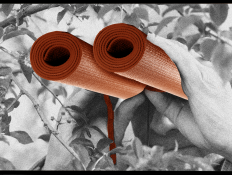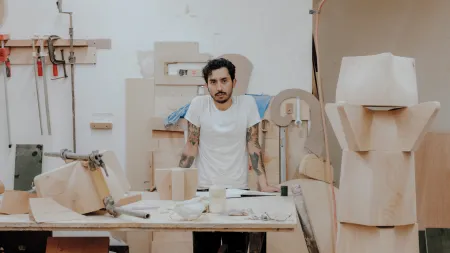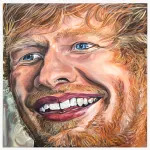
A few years ago, Ryan Preciado began frequenting a hardware store less than a mile from his main studio in the Los Angeles neighborhood of Arlington Heights. Slowly, he began befriending the family who runs the shop. When the store got busy, Preciado started browsing its wares, “picking up little things I thought were pretty sculptural,” he said during an interview at his studio this past summer. “I’d bring them over to the owner, and we’d talk about them a bit in Spanish. Later, when he got a little more comfortable, he started doing the same thing.”
One such tool was a cross-shaped water shut-off wrench. Preciado recalls the owner telling him, “this thing is more sacred than a prayer—it actually puts food on people’s tables. I wish people would look at these things with as much importance as you and me.” That exchange led Preciado to create a series in which he scaled up that water wrench or the top of a pair of scissors, translating them into bronze and mounting them on wooden plinths. Preciado said he wanted to “give people the chance to look at the tools” with the same pride as the shop owner.
Another series came about as Preciado was driving by a construction site near Mariachi Plaza in Boyle Heights, where he saw a worker cutting slits in the privacy screens around the construction fences. “I pulled over, walked over to him, and asked him what he was doing, and he told me he was making vents for air, so the fence doesn’t knock over,” he said. The gashes reminded him of those in paintings by Lucio Fontana, a modernist known for slashing his monochromatic paintings, and the worker ended up borrowing Fontana’s name as a moniker. Preciado then made various sets of freestanding sculptures that take the forms of those oblong slits; he adapted them as individual pieces and as groups of six, in polished steel and in automotive-painted wood. “They’re all essentially portraits of these people,” he said, referring to the hardware store owner and the construction worker.
Preciado’s goal is to take in all the sights he sees and sounds he hears as he navigates LA. A series of lamps titled “Duke of Earl” takes its name from a 1962 song by Gene Chandler that he often listens to while stuck in traffic. Sometimes, when he’s in a hurry, he’ll take a quick photograph before driving away. The resulting image may or may not be in focus, and he doesn’t plot out the shots in advance. “I don’t question why I start something, otherwise I would probably hit a wall every time.”
He added that “the process is different each time. I’ll take it where I can get it.”
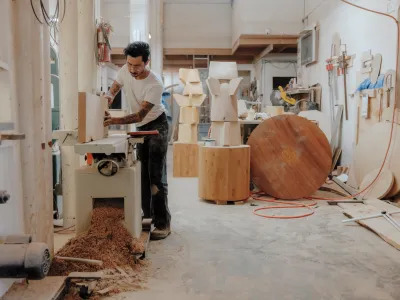
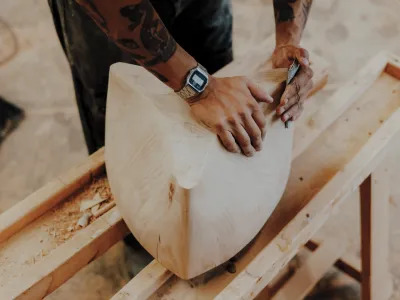
Preciado described his practice as “intuitive and open to change,” and in some ways, his journey to art-making was just as spontaneous. Born in 1989 in LA, he grew up in Nipomo, an unincorporated part of San Luis Obispo County in California’s Central Coast region. According to Preciado, the town doesn’t have much going for it aside from a steakhouse, a couple gas stations, and some labor-intensive jobs. Preciado worked several of these as a teenager, one of them as a commercial painter. “What I noticed [then] was, I always enjoyed the unfinished thing,” he said, like “the first few rolls of paint” on a house’s exterior. Eight months after he was hired as an assistant for a midcentury modern furniture maker, he dropped out of community college—not to become an artist, he specified, but to become a carpenter.
Preciado moved to LA around 10 years ago, and soon met Ryan Conder, the founder of South Willard, an enterprise in Chinatown that started out selling menswear and eventually became a full-fledged gallery. He started working there and met artists like Matt Connors, who a few years later became the first person to buy his art. Preciado also became an assistant for Peter Shire, working in his studio for some four years. Toward the end of his tenure with Shire, around 2018, Preciado began making artworks for himself. “I didn’t tell anyone,” he said. “I was just doing my own thing. I had no idea what I was doing, and there’s something exciting about that.”
Preciado now makes his art in three locations: his main drawing studio in Arlington Heights, where he sketches out his designs; a shared woodshop in South Central, where the carpentry for many of his sculptures takes place; and Jose Auto Body in East LA, where he works with the shop’s owner, José Angulo, to prime, sand, and paint the pieces.
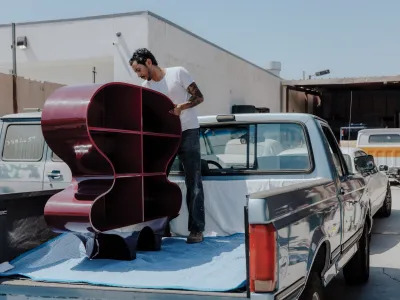
Despite how far away from each other his workspaces are, Preciado moves frequently between them. He often starts at his drafting table in Arlington Heights, an airy space that receives ample sunlight, with plenty of places to sit (made by Preciado himself). There are also works by his friends, including pieces by Connors, Louis Fratino, Sharif Farrag, and Magdalena Suarez Frimkess, whom Preciado met at a barbecue hosted by Conder and subsequently collaborated with on some tables.
The woodshop is also a site of experimentation. “The shop is just another place where I draw in real time,” he said. “I am so loose with how I make something, which is so unlike a carpenter.” At Jose Auto Body, which remains a functioning shop, he might even pitch in on some of the cars to help speed up Angulo’s getting down to work on his sculptures.
Preciado said his collaboration with Angulo, whom he met after his own truck needed some repair work, has been especially important. “He’s been such a necessary person in many ways—obviously with what he can bring to the table with his trade—but he cares and there’s no artistic motive. It’s a fresh perspective when working with someone like that.”
Jose Auto Body may be the most consequential space when it comes to Preciado’s finished works. The powder blue used for one egg-shape sculpture, for example, was left over from a paint job for a Toyota Hilux. “Sometimes, the color chooses me,” Preciado said with a laugh. Often, the colors he enlists reference those used by other artists, architects, and designers, such as Ettore Sottsass, Josef Albers, or Vico Magistretti, whose red is currently a font of creativity. The shapes of his works, meanwhile, allude to designs by Aldo Rossi, Mario Botta, Luis Barragán, Clara Porset, Josef Hoffmann, and Chucho Reyes.
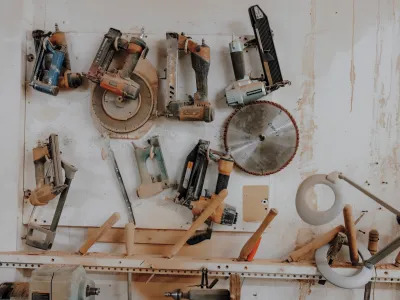
Nearly all Preciado’s projects have involved friendship, collaboration, and charla (conversation). “Downhearted Duckling,” a 2020 group show he organized for South Willard, included the work of artists whom he felt had helped him hone his artistic voice, including Suarez Frimkess, Mario Ayala, and rafa esparza, who painted Preciado’s portrait. In that painting, Preciado is seated in one of his Chumash chairs, a nod to his mother’s Indigenous ancestry.
When Preciado was included in the 2023 edition of the Hammer Museum’s Made in L.A. biennial, he showed several pieces, including Oceano Cabinet, a tall, narrow house-like construction. Within that sculpture, he displayed the work of other artists on its shelves and in its drawers, forming a group show unto itself. (The cabinet could be opened and closed. When he visited the galleries, Preciado opened it up; he gave his friends permission to do the same when he wasn’t there.) Pieces by Ozzie Juarez, Diana Yesenia Alvarado, Aaron Elvis Jupin, Paul Flores, and Matt Paweski appeared here, as did objects by fellow Made in L.A. participants such as Devin Reynolds, Esteban Ramón Pérez, and Roksana Pirouzmand. He called this presentation “a kind of comfort blanket.”
His first solo show in New York, at Canada, in 2022, came about through his friendship with Connors. Connors was having a show at the gallery’s main space at the time, and he helped Preciado get his exhibition in an adjacent project room. They published a monograph together, featuring the images they exchanged during the development of their shows. “We have this intimate language,” Preciado said. “We would just send each other images of things we thought were interesting, with almost no text.”
With that show, Preciado said, “I realized there’s not a wrong or right way to do something. Matt generously gave me the ability to not question why or how I’m making something. The understanding can come after—if at all.”
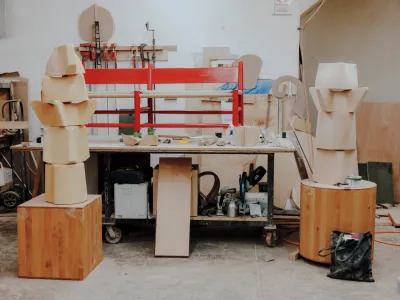
Over the summer, Preciado is preparing for two solo shows this fall. One will open at Karma, the taste-making New York gallery, in September. The other, a larger exhibition at the Palm Springs Art Museum, will follow in October.
“Ryan’s work fits in a very distinct place within art, functional design, and conceptual practice,” Brendan Dugan, Karma’s founder, told me. “What he is doing, and how tuned in he is to the objects and their language, is super exciting for me.”
His Karma show will feature several new works, including another house-like structure that will this time host several of his own works in a domestic setting. The back portion of the show will nod to his prior curatorial work and feature a new Preciado-designed piece to display the works of other artists, including Sayre Gomez, Jonas Wood, Elisabeth Kley, Woody De Othello, Grandma Preciado, and his old boss, Peter Shire.
The Palm Springs show focuses on Manuel Sandoval, who worked as a carpenter for several iconic 20th-century architects, most notably Frank Lloyd Wright. Preciado said he sees a dark side in Sandoval’s work with Wright, their close association effectively “stunting what [Sandoval] wanted to do, in my opinion.” It’s this kind of “lost labor” that Preciado wanted to highlight for his first institutional solo.
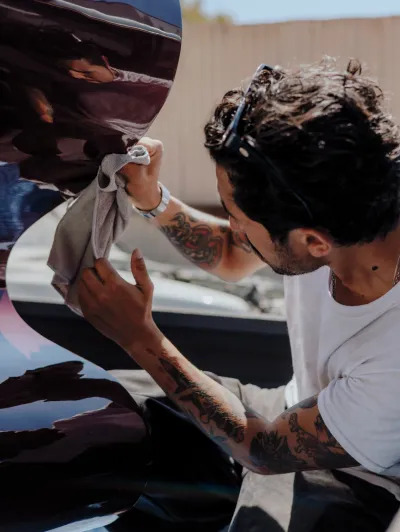
Preciado and the show’s curator, Robert J. Kett, researched Sandoval’s largely under-explored life and work. The lack of scholarship on Sandoval is itself a primary focus of the show, which puts his work into conversation with Preciado’s. Tracking down pieces for the exhibition was also difficult, given how few of his known works survive. Plus, even when Sandoval did work with high-profile architects, he rarely received credit in the historical record. Preciado said his own latest work is influenced “not by [Sandoval] specifically, but by how I was tracing his hand metaphorically through old blueprints.”
Preciado first learned of Sandoval through his friend Andrew Romano, who owns the Walker Residence, a home in LA’s Silverlake neighborhood designed by R.M. Schindler. Romano asked if Preciado might be interested in replicating the house’s original dining set, which Sandoval designed. Preciado wasn’t at first, but after Romano sent him the little information available on Sandoval and the drawings for the table, Preciado got to thinking about how he might resurrect the earlier artist’s legacy. Preciado did replicate Sandoval’s dining set; it features in the Palm Springs show.

Another work in that show draws on one of the few known stories about Sandoval’s life. Wright had lent Sandoval a pencil for a drawing and ultimately forgot to ask for it back. “Sandoval admired him so much that he made a box with a velvet lining for the pencil to keep on his desk, which is beautiful but also kind of dark, to me,” Preciado said. “So, I’m trying to replicate what I imagine that would look like.”
In fabricating works that Sandoval never realized, Preciado is giving form to inspiration that may otherwise have remained invisible. “I hate to say it’s very Frank Lloyd Wright–influenced,” Preciado said, “because, in my mind, it’s Manuel Sandoval.”
Taken together, both exhibitions represent Preciado’s steady evolution over the past six years. His practice eschews the long-held divisions between art and design. For him, both fields elicit the same emotions, though he noted that recently, his work is “becoming less and less functional as I go.”
A version of this article appears in the 2024 ARTnews Top 200 Collectors issue.
Is the Summer Group Show in New York Going the Way of the Dinosaur?
A&L Berg Foundation Launches New Program to Support Early-Career Latinx Art World Professionals
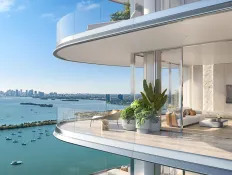
Luxury Automakers Are Racing to Build Design-Forward Branded Residences. Here’s Why.
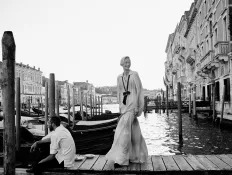
Tilda Swinton on ‘Complicity’ With Pedro Almodóvar, Julianne Moore and Embracing ‘Unguardedness’
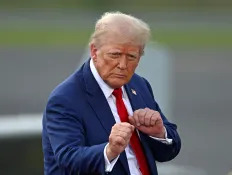
The Apprentice: What to know about the controversial movie starring Sebastian Stan as Trump

Turf Wars: NFL Is Finally Tackling Its Playing Surface Problem
